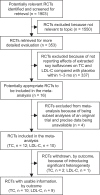Effects of extracted soy isoflavones alone on blood total and LDL cholesterol: Meta-analysis of randomized controlled trials
- PMID: 19209289
- PMCID: PMC2621412
- DOI: 10.2147/tcrm.s3262
Effects of extracted soy isoflavones alone on blood total and LDL cholesterol: Meta-analysis of randomized controlled trials
Abstract
When provided concurrently with soy protein for 1-3 months, soy isoflavones exert synergistic or additive cholesterol-lowering effects. This meta-analysis was performed to evaluate the effects of extracted soy isoflavones alone (not ingested concurrently with soy protein) on total and low density lipoprotein (LDL) cholesterol. MEDLINE (1966-2007), EMBASE (1966-2007), CENTRAL (1966-2007), ICHUSHI (1983-2008), and CNKI (1979-2007) were searched for randomized placebo-controlled trials published in English, Japanese, and Chinese, describing the changes in lipid profiles in adult humans resulting from ingestion of extracted soy isoflavones for 1-3 months. Reference lists of relevant systematic reviews and meta-analyses were hand-searched. Meta-analysis of 10 and 9 trials with usable information using REVMAN found that an average of 70 mg soy isoflavones/day (27-132 mg, as the aglycone form) alone had a nonsignificant effect on total (0.01 mmol/L [95% CI: -0.12, 0.14]; P = 0.86) and LDL (0.03 mmol/L [95% CI: -0.11, 0.16]; P = 0.71) cholesterol in menopausal women, respectively. It is concluded that ingestion of about 70 mg extracted soy isoflavones/day alone for 1-3 months does not improve total and LDL cholesterol levels in normocholesterolemic menopausal women; further studies are needed to verify the effects of extracted soy isoflavones.
Keywords: LDL cholesterol; extracted soy isoflavones; lipid; total cholesterol.
Figures


References
-
- Badeau R, Jauhiainen M, Metso J, et al. Effect of isolated isoflavone supplementation on ABCA1-dependent cholesterol efflux potential in postmenopausal women. Menopause. 2007;14:293–9. - PubMed
-
- Cassidy A, Albertazzi P, Lise Nielsen I, et al. Critical review of health effects of soyabean phyto-oestrogens in post-menopausal women. Proc Nutr Soc. 2006;65:76–92. - PubMed
-
- Cheng G, Wilczek B, Warner M, et al. Isoflavone treatment for acute menopausal symptoms. Menopause. 2007;14:468–73. - PubMed
-
- Clarkson TB, Anthony MS. Phytoestrogens and coronary heart disease. Baillieres Clin Endocrinol Metab. 1998;12:589–604. - PubMed
LinkOut - more resources
Full Text Sources

